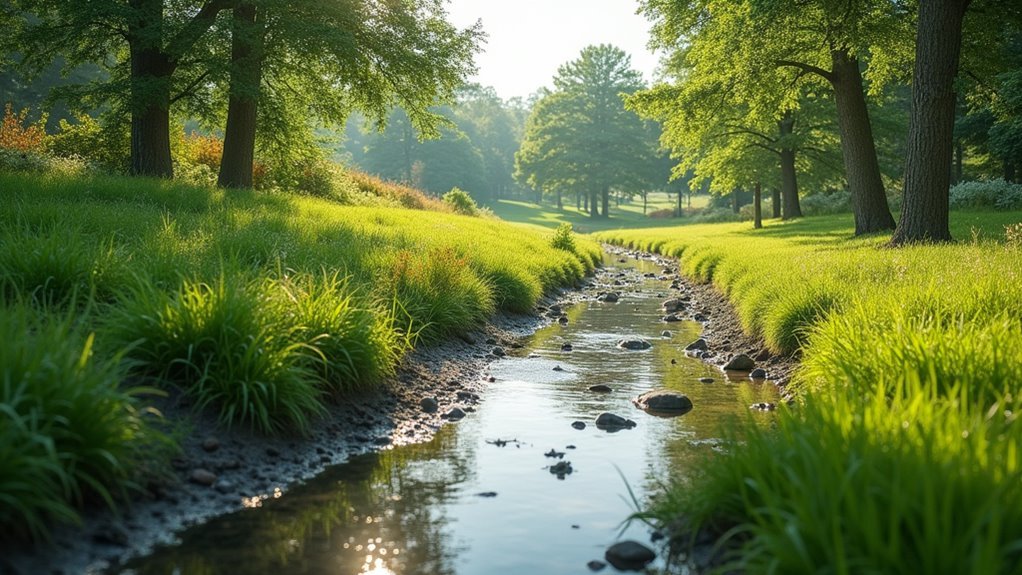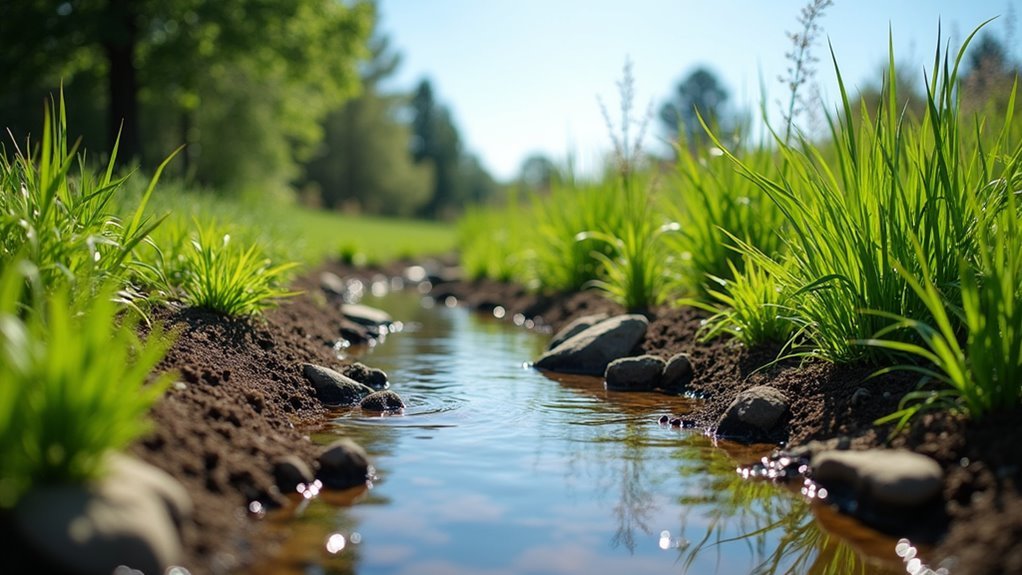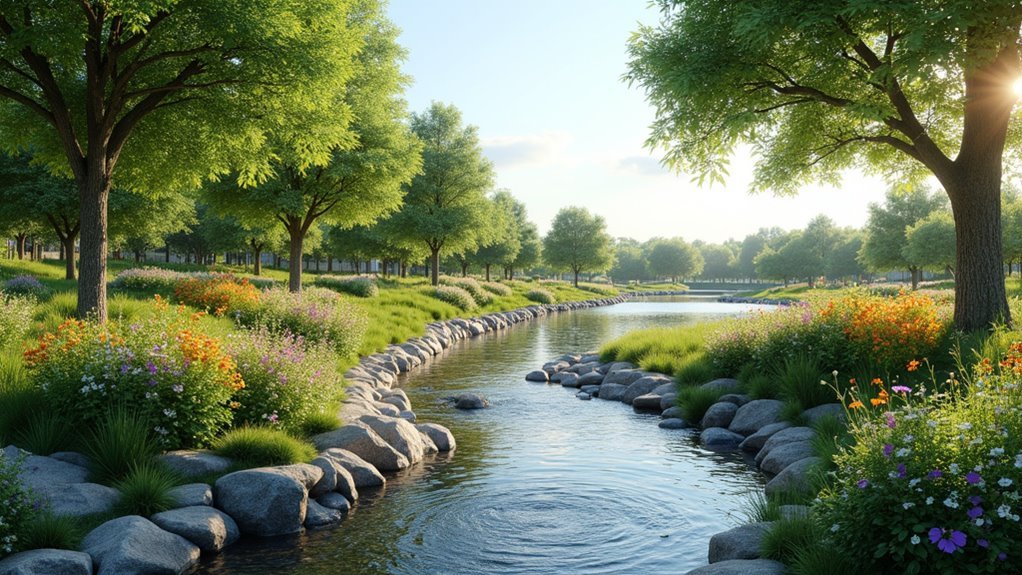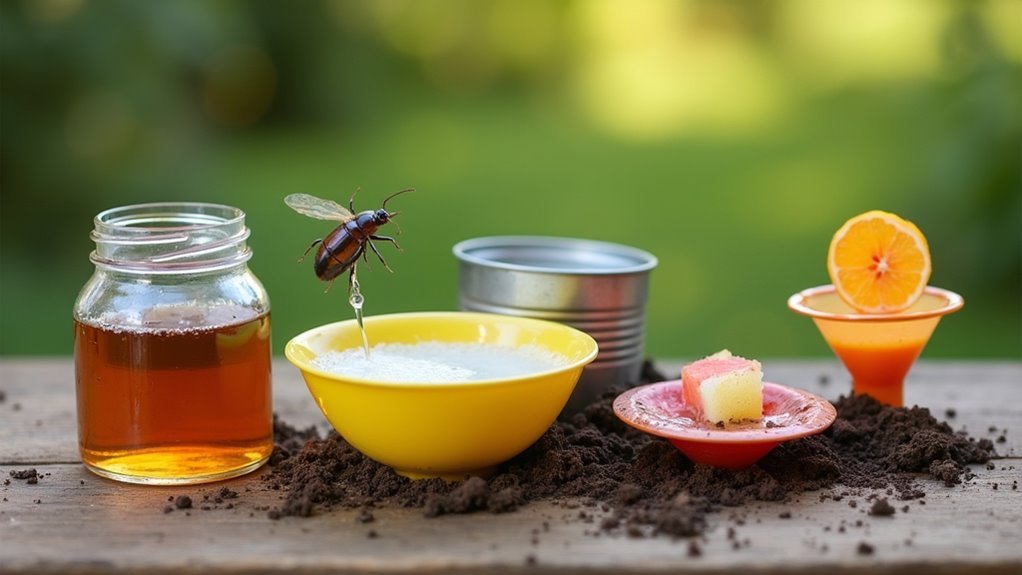You can eliminate mosquito breeding grounds by implementing strategic landscape drainage solutions that prevent standing water accumulation. Install bio-swales with native plants and gravel filtration to absorb runoff quickly, while creating rain gardens positioned above low-lying areas to intercept water flow. Clean gutters regularly, establish 2% slopes to direct water away from structures, and maintain catch basins with proper screens. These thorough drainage strategies will transform your property into an effective mosquito prevention system.
Understanding How Standing Water Creates Mosquito Breeding Grounds

When water accumulates around your property, you’re inadvertently creating perfect nurseries for mosquitoes. These pests need standing water to lay their eggs, and even the smallest puddle can become a breeding ground. A single water-filled container can produce hundreds of mosquitoes in just four days.
During their larval stage, which lasts 4 to 14 days, mosquitoes thrive in stagnant conditions. This means that forgotten flowerpot saucers, clogged gutters, or poorly draining areas become mosquito factories.
You’ll find that standing water in any form – whether it’s a birdbath, tire, or depression in your yard – provides the ideal environment for rapid mosquito reproduction. Understanding this connection between moisture accumulation and pest proliferation helps you target the root cause of mosquito problems.
Evaluating Your Property’s Natural Water Flow and Drainage Patterns
Most property drainage problems stem from failing to understand your land’s natural water movement patterns.
Start by walking your property during and after rainfall to observe where water collects naturally. Look for depressions, slopes, and areas where runoff converges into pools that could become mosquito breeding sites.
Walk your property during storms to identify natural water collection points and potential mosquito breeding areas.
Check your existing drainage infrastructure next. Clean debris from gutters and downspouts to guarantee proper water flow away from your foundation.
Examine how water moves from these systems and whether it’s creating new problem areas.
Conduct a simple soil percolation test by digging a hole and filling it with water. Time how quickly it drains to understand your soil’s absorption rate.
This information helps you determine whether you need enhanced drainage solutions like bio-swales or rain gardens to redirect water flow effectively.
Installing Bio-Swales for Effective Storm Water Management

Bio-swales offer a natural and highly effective solution for managing storm water runoff while simultaneously eliminating mosquito breeding opportunities on your property.
These gently sloped, vegetated channels promote infiltration and prevent standing water accumulation that mosquitoes need for reproduction.
Your bio-swale Water Management system should include:
- Native plant selection – drought-resistant grasses and flowering plants that absorb water quickly
- Gravel filtration layers – permeable stone beds that enhance drainage and prevent pooling
- Strategic slope positioning – gentle 2-5% grades that direct flow without creating erosion
- Regular maintenance schedule – monthly debris removal and sediment clearing to maintain peak function
Properly designed bio-swales reduce drainage system burden while creating habitat for beneficial insects that naturally control mosquito populations through biological pest management.
Creating Rain Gardens to Absorb and Filter Runoff
Since rain gardens function as natural collection basins, they’ll transform problematic runoff areas into beautiful, functional landscape features that eliminate mosquito breeding grounds.
You’ll want to position your rain gardens strategically above low-lying areas to intercept sheet flow before it stagnates. Design these depressed areas with proper gravel and soil layers that promote excellent drainage, preventing the standing water mosquitoes need for breeding.
Plant your rain gardens with native species that’ll filter water naturally while creating wildlife habitats.
Native plants in rain gardens create natural filtration systems while providing essential habitats for local wildlife species.
The key is ensuring water absorbs quickly rather than pooling. You’ll find that well-designed rain gardens not only manage stormwater effectively but also enhance your property’s aesthetic appeal, giving you a dual-purpose solution that’s both functional and visually striking.
Optimizing Catch Basin Design and Maintenance

You’ll need to focus on three critical aspects when enhancing your catch basin system for effective mosquito control.
First, guarantee proper water flow management through strategic placement of drainage holes that prevent standing water accumulation.
Next, implement debris prevention strategies and screen installation methods that keep mosquitoes out while maintaining ideal drainage performance.
Proper Water Flow Management
When you’re designing catch basins for effective landscape drainage, you’ll need to incorporate strategic drainage holes that prevent water from accumulating and creating mosquito breeding grounds. Proper water flow management eliminates stagnant areas where mosquitoes find prime conditions for water to lay their eggs.
Effective water flow strategies include:
- Elevating downspouts with proper slope angles that direct water away from collection points
- Installing protective screens over drainage openings to filter debris while maintaining peak flow
- Adding decorative stone covers around catch drains to improve drainage and conceal potential pooling areas
- Implementing bio-swales with cultek storm chambers that enhance urban water management systems
Regular maintenance guarantees debris doesn’t obstruct flow, keeping your landscape drainage functioning efficiently while preventing mosquito habitat formation.
Debris Prevention Strategies
Although standing water creates ideal mosquito breeding conditions, you can prevent debris accumulation in your catch basins through strategic design choices and consistent maintenance practices.
Install screens on your catch basins to filter out leaves, twigs, and other debris while maintaining proper water flow. These barriers prevent materials from clogging drainage holes and creating stagnant pools where mosquito larvae thrive.
Cover your catch drains with stones or sod to enhance drainage capabilities while creating a natural appearance. This technique improves water absorption and reduces debris collection.
Schedule regular cleaning sessions to remove accumulated materials before they block drainage systems. Check that drainage holes remain clear and functional during routine inspections.
Consistent maintenance guarantees your catch basins effectively manage storm water without providing breeding habitats for mosquitoes.
Screen Installation Methods
Proper screen selection forms the foundation of effective mosquito prevention in catch basins. When implementing screen installation methods, you’ll need to choose fine mesh materials that block mosquito entry while maintaining ideal water flow.
The installation process requires careful attention to fit and positioning to guarantee long-term mosquito control effectiveness.
Consider these essential installation steps:
- Measure your catch basin opening – guaranteeing the screen fits snugly without gaps where mosquitoes could enter
- Secure the mesh firmly – using appropriate fasteners that won’t corrode or loosen over time
- Test water flow capacity – verifying drainage isn’t compromised after installation
- Create accessible maintenance points – allowing easy removal for cleaning without disturbing the entire system
Regular inspection guarantees your screens continue providing reliable mosquito control.
Proper Downspout Installation and Extension Techniques
You’ll need to establish the right slope for your extension spouts to guarantee water flows away from your foundation efficiently.
Proper installation requires a minimum 1% downward grade to prevent water from pooling near your home’s base.
Regular maintenance of these extensions keeps debris from blocking water flow and creating stagnant areas where mosquitoes can breed.
Optimal Slope Requirements
When water flows efficiently away from your home’s foundation, you’re eliminating one of mosquitoes’ favorite breeding grounds. Meeting ideal slope requirements guarantees your downspouts channel water effectively, preventing the stagnant pools that attract these pests.
Proper drainage serves as essential mosquito control infrastructure around your property.
Your downspout installation must maintain specific slope standards:
- Minimum 1-2% grade – Picture water rushing down a gentle hill, carrying debris away rather than pooling in flat areas.
- Extension reaching 4-6 feet – Visualize a protective barrier zone around your foundation where water can’t accumulate.
- Corrugated extensions elevated properly – Imagine suspended pathways guiding water smoothly downward without creating dips.
- Clear, unobstructed flow paths – Envision water streaming freely like a mountain creek, never stalling or backing up.
Extension Spout Maintenance
After establishing the correct slope, maintaining your extension spouts becomes the critical next step in preventing mosquito-friendly water accumulation.
You’ll need to inspect and clean your spouts regularly, removing debris and blockages that create standing water where mosquitoes breed. Clogged spouts defeat even perfect slopes, so don’t overlook this maintenance.
Install corrugated extension spouts that flex with your landscape’s contours, directing water efficiently away from pooling areas.
Position discharge points at least 3 to 5 feet from your foundation to prevent seepage that creates breeding sites near your home.
Consider adding gutter guards to keep debris out of your system entirely.
This proactive approach maintains clear water flow and supports effective mosquito control throughout the seasons.
Grading and Slope Solutions to Prevent Water Accumulation
Since water naturally flows to the lowest point on your property, creating proper drainage starts with establishing the right grade and slope across your landscape. Effective grading directs water away from your home’s foundation and eliminates pooling areas where mosquitoes thrive.
To achieve ideal mosquito prevention through proper grading:
- Create a 2% slope – Visualize your yard gently tilting away from structures like a subtle ramp directing water toward designated drainage areas.
- Install contour grading – Picture curved channels that guide water flow naturally downhill, preventing stagnant pools in low-lying spots.
- Add vegetated swales – Imagine shallow, grass-lined ditches that absorb runoff while maintaining attractive landscaping.
- Maintain consistent grades – Envision smooth shifts without dips or depressions that trap water.
Storm Chamber Systems for High Impervious Surface Areas
When you’re dealing with large paved areas like driveways, parking lots, or patios, storm chamber systems offer an underground solution that prevents mosquito-breeding puddles from forming on your property.
You’ll need to understand the key benefits these systems provide, learn proper installation techniques for maximum effectiveness, and establish a maintenance routine to keep them functioning at their best.
Let’s examine how storm chambers can transform your high-traffic impervious areas into well-drained spaces that won’t harbor standing water.
Storm Chamber Benefits
Although impervious surfaces like parking lots and building rooftops create significant stormwater challenges, storm chamber systems offer an effective underground solution that transforms how you manage runoff on your property.
The storm chamber benefits extend far beyond basic drainage, providing effective mosquito control while meeting regulatory requirements. You’ll eliminate standing water that serves as mosquito breeding grounds while protecting local waterways from contaminated runoff.
Key advantages include:
- Underground storage – Water flows into chambers during heavy rainfall, creating invisible flood protection beneath your parking areas.
- Gradual release – Stored water slowly infiltrates surrounding soil, preventing surface pooling and mosquito reproduction.
- Traffic-resistant construction – Durable materials withstand vehicle weight and soil pressure in high-use commercial areas.
- Ecosystem protection – Reduced runoff volume maintains healthier local waterways and aquatic habitats.
Installation Best Practices
Proper installation of storm chamber systems requires careful attention to subgrade preparation and drainage flow patterns to maximize their effectiveness in high impervious surface areas.
You’ll need to guarantee chambers sit on well-drained subgrade that won’t compromise structural integrity. Create proper slopes to facilitate water flow and prevent stagnant pooling where mosquitoes thrive.
Position chambers strategically to capture maximum runoff from impervious surfaces like driveways and rooftops.
You’ll want to establish gradual infiltration rates that don’t overwhelm soil capacity. Install access points for routine maintenance and debris removal, preventing blockages that create mosquito breeding sites.
Consider incorporating features that support mosquito predators, such as drainage outlets that connect to areas where beneficial insects and amphibians naturally occur, creating biological control opportunities.
Maintenance Requirements
Since storm chamber systems require consistent upkeep to prevent mosquito breeding sites, you’ll need to establish a regular maintenance schedule that addresses debris removal, drainage inspection, and structural integrity checks.
Neglecting these systems creates stagnant water conditions where mosquitoes thrive and reproduce rapidly.
Your maintenance routine should include:
- Monthly debris clearing – Remove leaves, sediment, and organic matter that blocks water flow through chamber openings.
- Quarterly drainage hole inspection – Verify all outlet points remain unobstructed and water moves freely without pooling.
- Bi-annual structural assessment – Check for cracks, settling, or damage that could trap water in unintended areas.
- Annual professional evaluation – Schedule expert inspection to identify potential issues before they compromise mosquito prevention effectiveness.
Consistent maintenance eliminates mosquito breeding habitats while ensuring excellent stormwater management performance.
Passive Irrigation Design for Water Redirection
When excess water pools in your landscape, it creates ideal breeding conditions for mosquitoes, but passive irrigation design offers an elegant solution that works with nature’s own drainage patterns.
You’ll harness natural topography through strategic placement of swales and berms that redirect storm water away from problem areas. Design your landscape with appropriate slopes and drainage channels to guide runoff while promoting groundwater recharge.
Incorporate native plantings within your system to absorb excess moisture and attract natural mosquito predators. Whether you’re planning a water feature or addressing existing drainage issues, these plants enhance system effectiveness.
Remember that regular maintenance keeps your passive irrigation functioning properly, ensuring continued protection against standing water accumulation and mosquito breeding sites.
Maintaining Drainage Systems to Eliminate Breeding Habitats
Although passive irrigation creates the foundation for effective water management, your drainage system requires ongoing attention to prevent mosquito breeding habitats from developing.
Regular maintenance keeps water flowing properly and eliminates stagnant pools where mosquitoes reproduce.
Essential maintenance practices include:
- Clean gutters and catch basins monthly – Remove leaves, twigs, and debris that create dams, causing water to pool and stagnate in dark, protected areas perfect for mosquito larvae development.
- Install drainage holes in catch basins – Drill strategic openings that promote continuous water absorption, preventing accumulation that transforms these structures into breeding sanctuaries.
- Elevate downspouts with proper slope – Position extensions to direct water away from foundations, eliminating pooling near building perimeters.
- Add screens over catch basins – Install fine mesh barriers that filter debris while blocking mosquito access to interior water sources.
Frequently Asked Questions
What Can I Put in My Drain to Keep Mosquitoes Away?
You can add screens to your drain to filter out mosquitoes while maintaining proper water flow. Place natural repellents like citronella or essential oils near drain openings to deter mosquitoes effectively.
How Do Landscapers Keep Mosquitoes Away?
Landscapers eliminate standing water through proper grading and drainage systems. They’ll install rain gardens, bio-swales, and maintain gutters. You’ll also see them plant mosquito-repelling vegetation like citronella and lavender around your property.
How to Stop Mosquitoes From Breeding in Drains?
You’ll stop mosquitoes breeding in drains by regularly clearing debris, installing mesh screens, maintaining proper drainage slopes, using bio-swales for stormwater absorption, and keeping gutters clean with guards.
What Can I Put in My Plant Water to Keep Mosquitoes Away?
You can add a few drops of citronella or lavender essential oils to your plant water. Alternatively, mix in small amounts of apple cider vinegar or dish soap to deter mosquitoes and eliminate larvae effectively.
In Summary
You’ve learned how proper drainage eliminates mosquito breeding sites while managing stormwater effectively. You’ll need to assess your property’s drainage patterns, implement solutions like bio-swales and rain gardens, and maintain systems regularly. Don’t let standing water accumulate anywhere on your landscape. By combining grading improvements, catch basins, and passive irrigation design, you’ll create a mosquito-free environment that’s both functional and sustainable for your property.





Leave a Reply